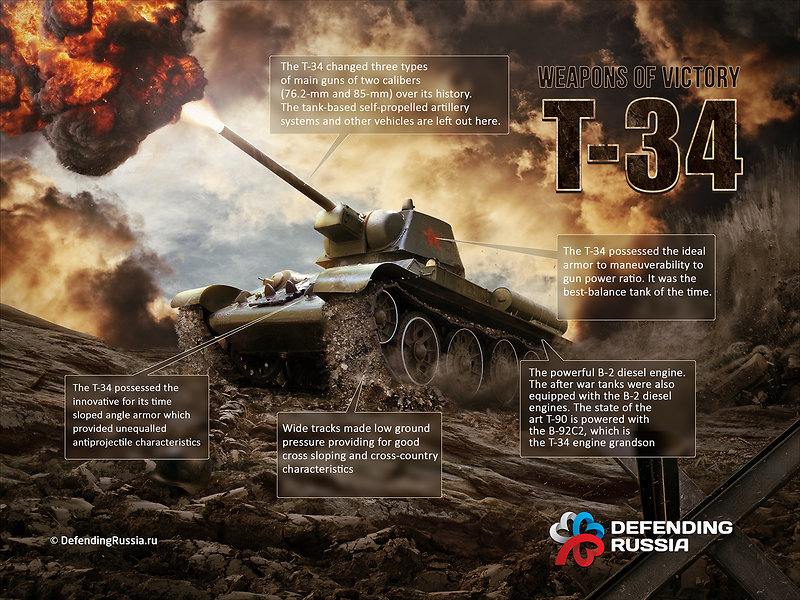T-34
Of all the Weapons of Victory the first thing to come about is its main symbol placed on the pedestals in many countries of the world. This is the T-34 medium tank.
The BT (BT stands for fast tanks) series tanks, mass-produced for the Red Army in the mid 1930ies, put the basis for the T-34 tank construction through the A-20 tank. The last vehicles of the series were equipped with diesel instead of gasoline engines. The BT series tanks in their turn were the result of reconsideration of the so-called «Christie's tanks”. Constructions invented by the American engineer John Christie contained a number of noteworthy engineering solutions, such as candle suspension and half-tracked running gear.
The T-34 inherited from the BT high power-to-weight ratio. The powerful BT engines (the 400 horsepower M-5 aircraft engine in the original) provided the vehicle with perfect maneuverability. The T-34 got the new B-2 diesel engine along with incomparable dynamic characteristics and maneuverability.
The tank hull was made of inclined armor sheets that provided high cannon proof projectile protection. We cannot say it was an original idea of the Soviet engineers but the T-34 was one of the best illustrations of the engineering decision put in serial production. Mind, that the German Pz. Kpfw V Panther was the result of attempting to copy the T-34 construction.
The T-34 was developed to fulfil the task of producing the 76.2-mm gun tank with cannon proof armor i. e. to pass to the customary WWII medium tank.
Note that the German 37-mm and 50-mm gun tanks significantly fell short of the T-34 in face-to-face combat in early war. It’s not the tanks that fought for Germany but an excellent system of tank troops and services cooperation in the battlefield.
By mid-War Germany had the 75-mm guns, later they mounted the 88-mm Flak 36 anti-aircraft gun on the tank platform. The Soviet weapon designers presented the brand-new T-34 — 85 with the ZIS-S-53 gun mounted on it.
The T-34 is the most widely produced tank in the history (the total number is over 80 thousand tanks of all types). The latest large-scale conflicts where they applied it were the 1974 Cyprus defense and the capture of Saigon by the North Vietnamese forces in 1975. It was also seen in the 1979 China-Vietnam war of 1979. The T-34 — 85 for the last time was appeared in the early 1990ies in Yugoslavia, but those were accidental episodes.
There is still some controversy as to whether the T-34 was the WWII best tank. This vehicle on one side had lots of disadvantages, though, most of them are the advantages' consequents. For instance, ease of operation, low production cost and lack of strict requirements for the crew’s skills. On the other side, we can find in other countries some tanks that surpassed the T-34 in certain characteristics. However, year-by-year both Russian and foreign experts give prize to the T-34. This can be easily explained. The T-34 was not the best vehicle except for one thing. It turned out to be the best-balanced and multipurpose tank if the War.
The combination of maneuverability, combat power and armor protection of the T-34 was close to the ideal but his opponents, possessing each one perfect characteristic, were worse in other. Considering ease of operation and low production cost, it turns out that it was the T-34 medium tank that played the lead in the Victory as medium in all thus the best.


Orphus system